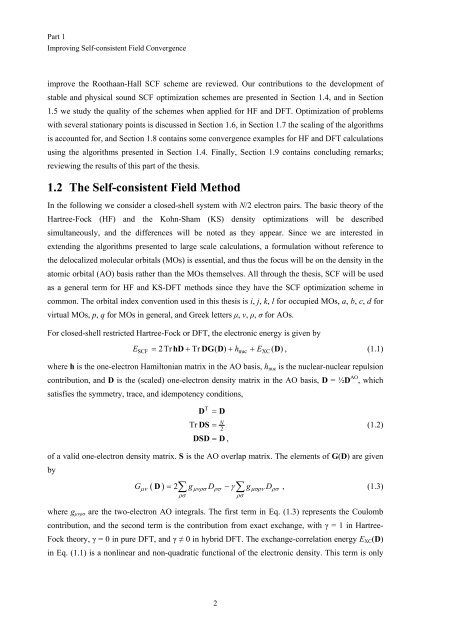Get my PhD Thesis
Get my PhD Thesis
Get my PhD Thesis
You also want an ePaper? Increase the reach of your titles
YUMPU automatically turns print PDFs into web optimized ePapers that Google loves.
Part 1<br />
Improving Self-consistent Field Convergence<br />
improve the Roothaan-Hall SCF scheme are reviewed. Our contributions to the development of<br />
stable and physical sound SCF optimization schemes are presented in Section 1.4, and in Section<br />
1.5 we study the quality of the schemes when applied for HF and DFT. Optimization of problems<br />
with several stationary points is discussed in Section 1.6, in Section 1.7 the scaling of the algorithms<br />
is accounted for, and Section 1.8 contains some convergence examples for HF and DFT calculations<br />
using the algorithms presented in Section 1.4. Finally, Section 1.9 contains concluding remarks;<br />
reviewing the results of this part of the thesis.<br />
1.2 The Self-consistent Field Method<br />
In the following we consider a closed-shell system with N/2 electron pairs. The basic theory of the<br />
Hartree-Fock (HF) and the Kohn-Sham (KS) density optimizations will be described<br />
simultaneously, and the differences will be noted as they appear. Since we are interested in<br />
extending the algorithms presented to large scale calculations, a formulation without reference to<br />
the delocalized molecular orbitals (MOs) is essential, and thus the focus will be on the density in the<br />
atomic orbital (AO) basis rather than the MOs themselves. All through the thesis, SCF will be used<br />
as a general term for HF and KS-DFT methods since they have the SCF optimization scheme in<br />
common. The orbital index convention used in this thesis is i, j, k, l for occupied MOs, a, b, c, d for<br />
virtual MOs, p, q for MOs in general, and Greek letters µ, ν, ρ, σ for AOs.<br />
For closed-shell restricted Hartree-Fock or DFT, the electronic energy is given by<br />
E = 2TrhD + Tr DG( D) + h + E ( D ), (1.1)<br />
SCF nuc XC<br />
where h is the one-electron Hamiltonian matrix in the AO basis, h nuc is the nuclear-nuclear repulsion<br />
contribution, and D is the (scaled) one-electron density matrix in the AO basis, D = ½D AO , which<br />
satisfies the symmetry, trace, and idempotency conditions,<br />
D<br />
T<br />
Tr DS =<br />
= D<br />
N<br />
2<br />
DSD = D ,<br />
(1.2)<br />
of a valid one-electron density matrix. S is the AO overlap matrix. The elements of G(D) are given<br />
by<br />
∑<br />
∑<br />
G ( D ) = 2 g D −γ g D , (1.3)<br />
µν µνρσ ρσ µσρν ρσ<br />
ρσ<br />
ρσ<br />
where g µνρσ are the two-electron AO integrals. The first term in Eq. (1.3) represents the Coulomb<br />
contribution, and the second term is the contribution from exact exchange, with γ = 1 in Hartree-<br />
Fock theory, γ = 0 in pure DFT, and γ ≠ 0 in hybrid DFT. The exchange-correlation energy E XC (D)<br />
in Eq. (1.1) is a nonlinear and non-quadratic functional of the electronic density. This term is only<br />
2

















